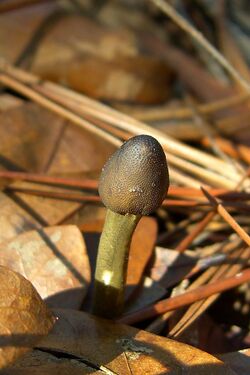Biology:Hypocreales
| Hypocreales | |
|---|---|

| |
| Tolypocladium sp. | |
| Scientific classification | |
| Domain: | Eukaryota |
| Kingdom: | Fungi |
| Division: | Ascomycota |
| (unranked): | Sordariomyceta |
| Class: | Sordariomycetes |
| Subclass: | Hypocreomycetidae |
| Order: | Hypocreales Lindau (1897) |
The Hypocreales are an order of fungi within the class Sordariomycetes. In 2008, it was estimated that it contained some 237 genera, and 2647 species in seven families.[1] Since then, a considerable number of further taxa have been identified, including an additional family, the Stachybotryaceae.[2] Wijayawardene et al. in 2020 added more families and genera to the order.[3] According to the Catalog of Life, (As of April 2021) the Hypocreales contains 6 families, 137 genera, and 1411 species.[4] Hyde et al. (2020a) listed 14 families under Hypocreales, while, Wijayawardene et al. (2022) accepted 15 families in the order,[5] where Cylindriaceae was additionally added. Earlier, Hyde et al. (2020a) had placed Cylindriaceae in class Xylariomycetidae.[6] Samarakoon et al. (2022) agreed.[7] Hence, Cylindriaceae should have been excluded from Hypocreales and placed in Xylariomycetidae. Xiao et al. (2022) recently introduced a new family Polycephalomycetaceae to Hypocreales.[8]
Description
Species of Hypocreales are usually recognized by their brightly colored, perithecial ascomata, or spore-producing structures. These are often yellow, orange or red.
Families
(with amount of genera);[3][5]
- Bionectriaceae (47)
- Calcarisporiaceae (1)
- Clavicipitaceae (50)
- Cocoonihabitaceae (1)
- Cordycipitaceae (21)
- Flammocladiellaceae (1)
- Hypocreaceae (17)
- Myrotheciomycetaceae (4)
- Nectriaceae (70)
- Niessliaceae (21)
- Ophiocordycipitaceae (12)
- Polycephalomycetaceae
- Sarocladiaceae (comprises two genera, Parasarocladium - 9 species and Sarocladium - 30 species)
- Stachybotryaceae (39)
- Tilachlidiaceae (3)
Genera incertae sedis
According to a 2020 review of fungal classification, the following genera within the Hypocreales have an uncertain taxonomic placement (incertae sedis), and have not been assigned to any family:[3]
- Acremoniopsis A.Giraldo, Gené & Guarro (2014) – 1 sp.
- Andreaeana (Palm & Jochems) Palm & Jochems (1924) - 1 sp.[9]
- Bulbithecium Udagawa & T.Muroi (1990) – 1 sp.
- Cephalosporiopsis Peyronel (1916) – 10 spp.
- Chondronectria Etayo, Flakus & Kukwa (2017) – 1 sp.
- Cylindronectria Etayo (2017) – 1 sp.
- Diploospora Grove (1916) – ca. 7 spp.
- †Entropezites[10] Poinar & R.Buckley 2007) – 1 sp.
- Gynonectria Döbbeler (2012) – 1 sp.
- Hapsidospora Malloch & Cain (1970) – 2 spp.
- Haptospora G.L.Barron (1991) – 3 spp.
- Illosporiopsis D.Hawksw. (2001) – 1 sp.
- Illosporium Mart. (1817) – 17 spp.
- Leptobarya Etayo (2017) – 2 spp.
- Metadothella Henn. (1904) – 1 sp.
- Munkia Speg. (1886) – 4 spp.
- †Mycetophagites[10] Poinar & R.Buckley (2007) – 1 sp.
- Neomunkia Petr. (1847) – 1 sp.
- Peloronectria Möller (1901) – 3 spp.
- Pseudoacremonium Crous (2014) – 1 sp.
- Pseudomeliola Speg. (1889) – 10 spp.
- Rodentomyces Doveri, Pecchia, Sarrocco & Vannacci (2016) – 1 sp.
- Roselliniella Vain (1921) – 19 spp.
- Saksenamyces A.N.Rai & P.N.Singh (2018) – 1 sp.
- Sedecimiella K.L.Pang, Alias & E.B.G.Jones (2010) – 1 sp.
- Stanjemonium W.Gams, O'Donnell, Schroers & M.Chr. (1999) – 4 spp.
- Stilbella Lindau (1900) – 61 spp.
- Ticonectria Döbbeler (1998) – 3 spp.
- Tilakidium Vaidya, C.D.Naik & Rathod (1986) – 1 sp.
References
- ↑ Dictionary of the Fungi (10th ed.). Wallingford, UK: CAB International. 2008. p. 332. ISBN 978-0-85199-826-8.
- ↑ Lombard, L; Houbraken, J; Decock, C; Samson, RA; Meijer, M; Réblová, M; Groenewald, JZ; Crous, PW (2016). "Generic hyper-diversity in Stachybotriaceae". Persoonia 36: 156–246. doi:10.3767/003158516X691582. PMID 27616791.
- ↑ 3.0 3.1 3.2 Wijayawardene, Nalin; Hyde, Kevin; Al-Ani, Laith Khalil Tawfeeq; Somayeh, Dolatabadi; Stadler, Marc; Haelewaters, Danny et al. (2020). "Outline of Fungi and fungus-like taxa". Mycosphere 11: 1060–1456. doi:10.5943/mycosphere/11/1/8.
- ↑ Source dataset. Species Fungorum Plus: Species Fungorum for CoL+. "Sordariales". Catalog of Life. https://www.catalogueoflife.org/data/taxon/445.
- ↑ 5.0 5.1 Wijayawardene, N.N.; Hyde, K.D.; Dai, D.Q.; Sánchez-García, M.; Goto, B.T.; Saxena, R.K. et al. (2022). "Outline of Fungi and fungus-like taxa – 2021". Mycosphere 13 (1): 53–453 [160]. doi:10.5943/mycosphere/13/1/2. https://www.researchgate.net/publication/358798332.
- ↑ Hyde, Kevin D.; Norphanphoun, C.; Maharachchikumbura, S.S.N.; Bhat, D.J.; Jones, E.B.G.; Bundhun, D.; Chen, Y.J.; Bao, D.F. et al. (2020). "Refined families of Sordariomycetes.". Mycosphere 11: 305–1059. doi:10.5943/mycosphere/11/1/7.
- ↑ Samarakoon, M.C.; Hyde, Kevin D.; Maharachchikumbura, S.S.M.; Stadler, M.; Jones, E.B.G.; Promputtha, I.; Suwannarach, N.; Camporesi, E. et al. (2022). "Taxonomy, phylogeny, molecular dating and ancestral state reconstruction of Xylariomycetidae (Sordariomycetes).". Fungal Divers. 112 (1): 1–88. doi:10.1007/s13225-021-00495-5.
- ↑ Xiao YP, Wang YB, Hyde KD, Eleni G, Sun JZ, Yang Y, Meng J, Yu H, Wen TC (2023), Polycephalomycetaceae, a new family of clavicipitoid fungi segregates from Ophiocordycipitaceae. Fungal divers, In progress
- ↑ "Species Fungorum - GSD Species". http://www.speciesfungorum.org/Names/GSDSpecies.asp?RecordID=262936.
- ↑ 10.0 10.1 "Evidence of mycoparasitism and hypermycoparasitism in Early Cretaceous amber". Mycological Research 111 (4): 503–506. 2007. doi:10.1016/j.mycres.2007.02.004. PMID 17512712.
External links
Wikidata ☰ Q132255 entry
 |

